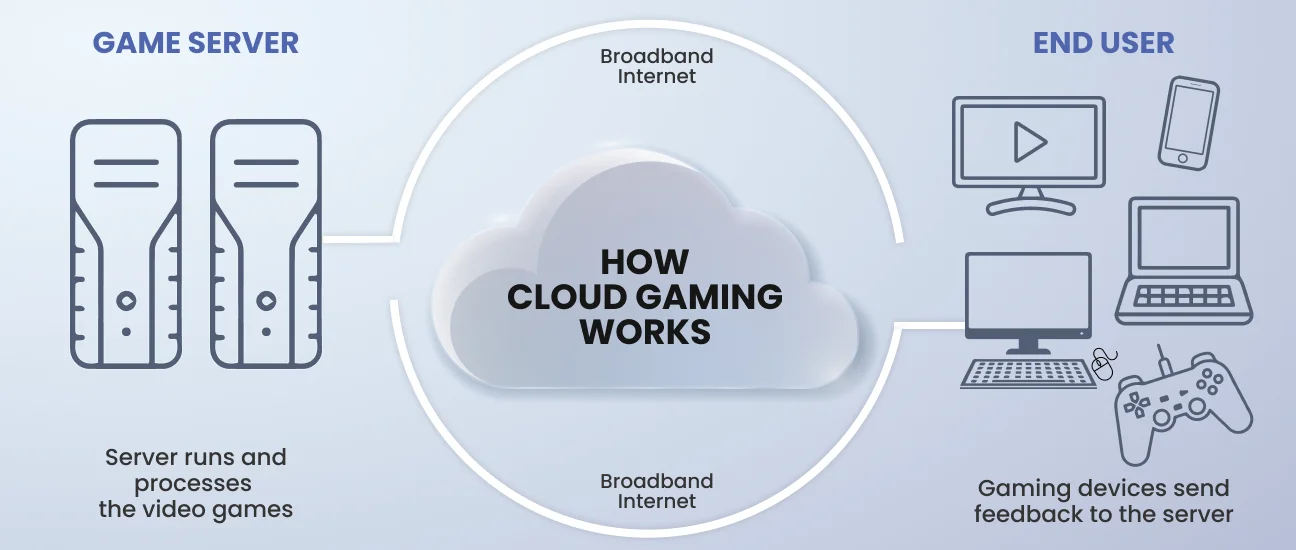
A Definitive Guide to Cloud Gaming
Cloud games utilize cloud computing infrastructure for various aspects of development and gameplay, allowing developers to leverage remote servers to handle many tasks without requiring much hardware support. The blog explores the advantages of cloud game development, revealing cloud functionalities and future scope. It delves into important parts of cloud gaming, including cloud gaming platforms, deployment strategies, and integration of cloud services like development costs, storage, analytics, key components, etc.
Gaming has come a long way, from pixelated screens and chunky consoles to mobile phones. Now, with cloud gaming, you can play your favorite games anytime, anywhere without requiring hardware. So, no need to rely on a bulky console or high-end computer.
In this new era, you can stream and render games remotely and access them on a multitude of devices with unprecedented ease. But have you ever thought about how these cloud games are made? What goes into their development, and what is difference between cloud games and traditional games?
In this cloud game development guide, we will reveal the intricacies and potential of cloud games and help you understand their significance in the gaming industry. We will demystify the core concepts, offering a foundational understanding that both novices and seasoned professionals can appreciate.
What is Cloud Gaming?
Cloud gaming is a technology that utilizes remote servers hosted on the internet to render and stream game content to players’ devices. Unlike traditional gaming, where the game software is installed and executed locally on the user’s device, cloud gaming offloads the processing and rendering tasks to powerful servers located in data centers.
How Do Cloud Games Work?
When a player launches a game through a cloud gaming service, it stores the game app and associated data and processes it on remote servers. These servers handle tasks like graphics rendering, game logic running, and managing player input. Later, the rendered game content is streamed over the internet to the player’s device in real time.

This video stream includes the visuals and audio of the game, allowing players to interact with the game as if it were running locally on their device. Player inputs, such as controller commands or keyboard/mouse actions, are sent from the player’s device to the remote servers.
These inputs are processed on the servers, and the game responds accordingly. The resulting changes to the game state are sent back to the player’s device via the streaming connection. The player’s device displays the streamed game content, allowing them to see and hear the game in real time.
How Cloud Gaming is Changing the Gaming Landscape?
The cloud gaming industry is poised to attract substantial growth in the upcoming years. Statista experts forecast that by 2024, the global revenue for this sector will soar to approximately US$6.91 billion. This upward trajectory is anticipated to persist, with a compound annual growth rate (CAGR) of 29.64% projected from 2024 to 2029. Consequently, the market size is expected to surge to US$25.30 billion by 2029.
According to experts, the rollout of 5G networks will improve latency and bandwidth, enhancing the feasibility of high-quality cloud gaming experiences on mobile devices and enabling seamless streaming of graphically intensive games.
Edge computing technology will strengthen its position in the industry and reduce latency by processing gaming data closer to the user, resulting in smoother gameplay experiences and better responsiveness, particularly for competitive gaming.
The popularity of subscription-based models for accessing games will continue to rise, with more gaming companies offering all-you-can-play access to their libraries for a fixed monthly fee, providing gamers with greater value and flexibility.
AI and ML algorithms will be utilized to optimize game streaming performance and personalized recommendations, and enhance player experiences by analyzing gameplay data and preferences. Cross-platform progression and save synchronization will become standard features, allowing players to seamlessly switch between devices while retaining their progress, achievements, and in-game purchases.
Key Components of Cloud Gaming Infrastructure
Cloud gaming infrastructure comprises several key components working together to deliver seamless gaming experiences to players. These components include:
Data Centers
Data centers are the foundation of cloud gaming infrastructure. They upkeep servers and hardware setup required to process and stream games to users over the internet. These data centers are typically equipped with high-performance GPUs, CPUs, and networking infrastructure optimized for low-latency streaming.
Streaming Protocols
Cloud gaming platforms utilize streaming protocols to deliver game content from the data centers to users’ devices in real-time. Common protocols include RTMP (Real-Time Messaging Protocol), WebRTC (Web Real-Time Communication), and proprietary protocols developed by cloud gaming providers.
Content Delivery Networks (CDNs)
CDNs help distribute game content efficiently to users worldwide by caching and delivering data from edge servers located closer to the end users. It ensures smooth gameplay for all players, especially for users located far from the data centers.
Encoding and Compression Technologies
To minimize bandwidth requirements and reduce latency, cloud gaming platforms employ advanced encoding and compression techniques to compress game video and audio streams before transmitting them to users’ devices. It facilitates smoother gameplay experiences over various network conditions.
Network Infrastructure
A robust network infrastructure with high-bandwidth connections and low-latency routing is essential for delivering cloud gaming content to users with minimal delay. Cloud gaming providers often partner with internet service providers (ISPs) and content delivery networks (CDNs) to optimize network performance and reduce latency.
Also read: NFT Game Development: An Ultimate Guide
How to Develop Cloud Games?
The process of cloud game development involves several key steps to convert ideas into a thrilling game that keeps players asking for more.
Development Environment Set Up
Start by defining the game concept, including its storyline, characters, mechanics, and target audience. Create detailed game design documents outlining gameplay mechanics, level designs, user interfaces, and the rest of the tech stack.
For development, you can choose from game engines like Unity or Unreal Engine. Unity supports Microsoft C#, C++, and JavaScript, whereas Unreal supports C++ programming language. You should make the choice based on expertise and available resources.
Along with these two, GameMaker, Amazon Lumberyard, and CryEngine are some other popular game engines that you can choose from.
Game Mechanics
Outline crucial mechanics like weapons, power-ups, character movements, appearance, number of stages, collision detection, scoring, artificial intelligence behavior, etc. Then choose a cloud platform or service provider that best suits your game’s requirements in terms of scalability, performance, and cost-effectiveness.
Coding and Development
Create or import visuall assets such as 2D or 3D models, textures, animations, and special effects and integrate them into the game enviornment. Work on sound effects, background music and voice overs to improve the gameplay experience. Ensure seamless integration of these audio elements with gameplay events and player actions.
Use game development tools and frameworks and code the game logic, create graphics, sound effects and other components. Integrate cloud-based features such as multiplayer support, storage capacity, leaderboards, voice chat, and processing.
Testing and Debugging
Refine design specifications and verify game features and mechanics accordingly. Test the gameplay scenarios, including single-player and multiplayer modes, to ensure smooth and error-free interactions.
Test the game on different devices, operating systems, and screen resolutions to ensure compatibility and consistent performance across various platforms. Pay special attention to differences in hardware capabilities, input methods, and network conditions.
Use debugging tools and techniques to identify and fix bugs, errors, and unexpected behaviors in the game’s code. Implement robust error handling mechanisms to gracefully handle runtime errors, exceptions, and edge cases without crashing or disrupting the player experience.
Continuous Integration and Deployment Strategies
Adopt CI/CD practices to accelerate the development cycle, improve code quality, reduce deployment risks, and deliver updates to players faster and more reliably. Deploy the game to the chosen cloud platform, ensuring proper configuration and scalability to handle varying traffic and loads.
Adopt CI/CD practices to accelerate the development cycle, improve code quality, reduce deployment risks, and deliver updates to players faster and more reliably. Deploy the game to the chosen cloud platform, ensuring proper configuration and scalability to handle varying traffic and loads.

What is the Cost of Cloud-Based Game Development?
The cost of cloud-based game development can vary widely depending on various aspects, including game complexities, number of hired developers, technology stack, development process duration, and other specific requirements of the project.
Creating high-quality artwork, animations, sound effects, and music for games can be costly. Hiring talented artists and composers, purchasing or licensing assets, and investing in custom artwork and audio production can add to development expenses. To get an accurate budget estimation, you should consult a reliable game development company.
Also read: What are the Profound Advantages of Investing in AAA Game Development?
Why Choose 300Mind for Cloud Game Development?
When it comes to cloud-based game development, 300Mind stands out as the premier choice. Our game designers and developers have an in-depth understanding of game development and cloud computing technologies. Utilizing their boundless expertise, they create innovative and immersive gaming experiences that harness the power of the cloud to its fullest potential.
Our commitment to quality is unmatched. We adhere to industry best practices and leverage cutting-edge tools and technologies to deliver high-performance, scalable, and secure cloud-based games. Whether it’s implementing multiplayer functionality, optimizing network performance, or integrating cloud services, we go above and beyond to ensure that every aspect of the game meets the highest standards of excellence.
FAQs About Cloud Game Development
Some of the most popular cloud games are Octopath Traveler, Sea of Thieves, Control, Forza Horizon 4, A Plague Tale: Innocence, Minecraft Dungeons, Dragon Quest XI, etc. With time, the gaming industry is evolving, and more games are coming to the market, influencing players to play the game with new technologies.
Cloud-based game development follows a structured methodology encompassing requirement analysis, design, development, testing, deployment, and maintenance phases. Collaboration, communication, and adaptation are key throughout the process, enabling developers to create successful cloud-based games that resonate with players.
Technologies, including cloud computing infrastructure like Amazon Web Services (AWS), Microsoft Azure, and Google Cloud Platform and game engines such as Unity, Godot, GameMaker, Unreal Engine, etc., are primarily used to build cloud games. Along with it, technologies, including GPUs, virtualization (Docker and Kubernetes), streaming technology (WebRTC, RTMP, HLS, and MPEG-DASH), content delivery networks (CDNs), compression, encoding algorithms, video codecs, AI & ML, AR &VR, etc., are used to build cloud-based games.








